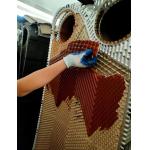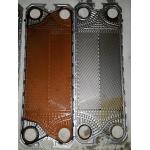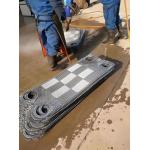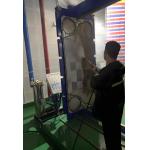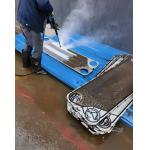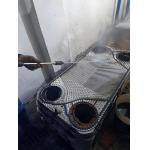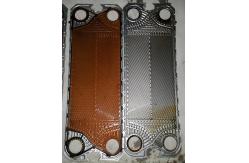The acid detergent disassembly and cleaning service is a
professional solution for plate heat exchangers, combining chemical
dissolution with physical disassembly to efficiently remove
stubborn deposits such as scale, rust, oil stains, and biological
slime from the surface of heat exchanger plates. This restores the
equipment's heat transfer efficiency and extends its service life.
The service is applicable to plate heat exchangers in industries
like chemical engineering, food, pharmaceuticals, and HVAC that
have experienced reduced heat transfer efficiency due to scaling. Preliminary Inspection and Assessment - Check the operating parameters of the heat exchanger (such as
temperature difference between inlet and outlet, pressure drop) to
determine the degree and type of scaling.
- Record the number of plates, arrangement sequence, and gasket
status before disassembly to avoid errors during reassembly.
Design of Chemical Cleaning Plan - Selection of acid detergents: Choose suitable acidic agents based on the composition of the
scale (such as calcium carbonate, calcium sulfate, metal oxides,
etc.). Common agents include:
- Citric acid: Suitable for light to moderate scale, with low
corrosion and high safety.
- Oxalic acid/hydrochloric acid: Aimed at severe rust scale or
sulfate scale, with high cleaning efficiency, but the concentration
(usually 1%-5%) and cleaning time (≤2 hours) must be strictly
controlled to avoid corrosion of plates (e.g., 316L stainless
steel).
- Composite acid cleaners: Added with corrosion inhibitors and
surfactants to enhance cleaning effects and protect metal surfaces.
- Cleaning process:
- Circulating cleaning: Pump the acid detergent into the heat
exchanger and circulate it at a flow rate of 0.3-0.5 m/s for 30-60
minutes to dissolve the scale layer.
- Soaking cleaning: For stubborn scaling, soak for 15-30 minutes
before circulation to enhance the dissolution effect.
Disassembly and Physical Cleaning - Remove the clamping bolts in sequence, separate the plate pack,
inspect whether the gaskets are aged or damaged, and replace them
in a timely manner.
- Rinse the surface of the plates with a high-pressure water gun
(pressure ≤10 MPa) to flush away residual scale, and use a soft
brush to remove deposits in hard-to-reach areas. Avoid using hard
tools like steel wool to scratch the plates.
Neutralization and Rinsing - After cleaning, circulate a 1%-2% sodium carbonate or sodium
hydroxide solution for neutralization to prevent residual acid from
corroding the plates.
- Rinse repeatedly with deionized water or soft water until the pH
value of the outlet water is close to 7 and the conductivity is ≤10
μS/cm.
Assembly and Debugging - Assemble the plates in the original order, ensure the gaskets are
installed in place, tighten the clamping bolts evenly in a diagonal
sequence, and control the torque within the manufacturer's
specified range (e.g., 15-25 N·m).
- Conduct a hydraulic pressure test (1.25 times the working pressure,
hold for 30 minutes), check for any leaks, resume equipment
operation, and record the parameters after cleaning.
| Advantages | Detailed Description | | High-efficiency descaling | Acid detergents dissolve over 95% of inorganic scale, and heat
transfer efficiency can be improved by 30%-50% after cleaning. | | Customized solutions | Adjust the agent formula according to the plate material (stainless
steel, titanium alloy, etc.) and scaling type to avoid material
damage. | | Safety and environmental protection | Use low-toxic corrosion-inhibiting acid agents and equip with
wastewater treatment devices. The cleaning wastewater can meet
discharge standards after neutralization. | | Prolong equipment life | Removing scale can reduce the operating pressure of the equipment,
reduce the risk of plate corrosion and perforation, and extend the
replacement cycle by 1-2 years. |
Application scenarios: - Scaling in plate heat exchangers of heating systems leading to
unmet room temperature standards;
- Blocked flow channels in heat exchangers supporting chemical
reactors due to material crystallization;
- Protein and oil deposits in heat exchangers of the food and
beverage industry affecting sterilization effects.
- Safety protection: Operators must wear acid-resistant gloves and goggles. Prepare
neutralizers and flushing water sources on-site to prevent acid
agents from contacting the skin or splashing into the eyes.
- Material compatibility: Do not use hydrochloric acid to clean aluminum plates. Special
weak acid cleaners should be selected for titanium plates to avoid
crevice corrosion.
- Cycle recommendation: Depending on water quality and working conditions, cleaning is
recommended every 6-12 months. For working conditions with high
water hardness (>300 mg/L) or easy scaling, the cycle can be
shortened to 3-6 months.
|
